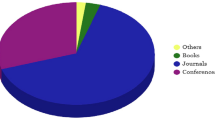Abstract
In the article, a yes–no model of influence is generalized to a multi-choice framework. We introduce and study the weighted influence indices of a coalition on a player in a social network where the players have an ordered set of possible actions. Each player has an inclination to choose one of the actions. Due to the mutual influence among players, the final decision of each player may be different from his original inclination. In a particular case, the decision of the player is closer to the inclination of the influencing coalition than his inclination was, i.e., the distance between the inclinations of the player and of the coalition is greater than the distance between the decision of the player and the inclination of the coalition in question. The weighted influence index which captures such a case is called the weighted positive influence index. We also consider the weighted negative influence index where the final decision of the player goes farther away from the inclination of the coalition. We consider several influence functions defined in the generalized model of influence and study their properties. The concept of a follower of a given coalition and its particular case, a perfect follower, are defined. The properties of the set of followers are analyzed.
Similar content being viewed by others
References
Albizuri, M. J., & Zarzuelo, J. M. (2000). Coalitional values for cooperative games with r alternatives. TOP, 8, 1–30.
Amer, R., Carreras, F., & Magaña, A. (1998). The Banzhaf-Coleman index for games with r alternatives. Optimization, 44, 175–198.
Bolger, E. M. (1986). Power indices for multicandidate voting games. International Journal of Game Theory, 14, 175–186.
Bolger, E. M. (1993). A value for games with n players and r alternatives. International Journal of Game Theory, 22, 319–334.
Bolger, E. M. (2000). A consistent value for games with n players and r alternatives. International Journal of Game Theory, 29, 93–99.
Bolger, E. M. (2002). Characterizations of two power indices for voting games with r alternatives. Social Choice and Welfare, 19, 709–721.
Braham, M., & Steffen, F. (2002). Voting power in games with abstentions. In M. J. Holler, H. Kliemt, D. Schmidtchen, & M. E. Streit (Eds.), Power and fairness (pp. 333–348). Mohr-Siebeck.
Dubey, P., & Shapley, L. S. (1979). Mathematical properties of the Banzhaf power index. Mathematics of Operations Research, 4, 99–131.
Felsenthal, D., & Machover, M. (1997). Ternary voting games. International Journal of Game Theory, 26, 335–351.
Felsenthal, D., & Machover, M. (1998). The measurement of voting power: Theory and practice, problems and paradoxes. London: Edward Elgar Publishers.
Felsenthal, D., & Machover, M. (2001). Models and reality: The curious case of the absent abstention. In M. J. Holler & G. Owen (Eds.), Power indices and coalition formation (pp. 87–103). Dordrecht: Kluwer.
Fishburn, P. C. (1973). The theory of social choice. Princeton: Princeton University Press.
Freixas, J. (2005). Banzhaf measures for games with several levels of approval in the input and output. Annals of Operations Research, 137, 45–66.
Freixas, J. (2005). The Shapley-Shubik power index for games with several levels of approval in the input and output. Decision Support Systems, 39, 185–195.
Freixas, J., & Zwicker, W. S. (2003). Weighted voting, abstention, and multiple levels of approval. Social Choice and Welfare, 21, 399–431.
Grabisch, M., & Rusinowska, A. (2008). Influence functions, followers and command games. Working paper, CES University of Paris 1, 2008.
Grabisch, M., & Rusinowska, A. (2009). Measuring influence in command games. Social Choice and Welfare, Forthcoming.
Grabisch, M., & Rusinowska, A. (2009). A model of influence in a social network. Theory and Decision, Forthcoming.
Hoede, C., & Bakker, R. (1982). A theory of decisional power. Journal of Mathematical Sociology, 8, 309–322.
Hsiao, C. R., & Raghavan, T. E. S. (1993). Shapley value for multichoice cooperative games. Games and Economic Behavior, 5,240–256.
Hu, X., & Shapley, L. S. (2003). On authority distributions in organizations: controls. Games and Economic Behavior, 45, 153–170.
Hu, X., & Shapley, L. S. (2003). On authority distributions in organizations: equilibrium. Games and Economic Behavior, 45, 132–152.
Isbell, J. R. (1958). A class of simple games. Duke Mathematical Journal, 25, 423–439.
Rusinowska, A. (2008). On the not-preference-based Hoede-Bakker index. In L. Petrosjan & V. Mazalov (Eds.), Game Theory and Applications (vol. 13). New York: Nova Science Publishers, Inc. Forthcoming.
Rusinowska, A. (2009). The Hoede-Bakker index modified to the Shapley-Shubik and Holler-Packel indices. Group Decision and Negotiation, Forthcoming.
Rusinowska, A., & De Swart, H. (2006). Generalizing and modifying the Hoede-Bakker index. In H. De Swart, E. Orlowska, G. Schmidt, & M. Roubens (Eds.), Theory and applications of relational structures as knowledge instruments II, LNAI 4342 (pp. 60–88). Heidelberg: Springer Verlag.
Rusinowska, A., & De Swart, H. (2007). On some properties of the Hoede-Bakker index. Journal of Mathematical Sociology, 31, 267–293.
Shapley, L. S. (1994). A Boolean model of organization authority based on the theory of simple games. Mimeo.
Tchantcho, B., Diffo Lambo, L., Pongou, R., & Mbama Engoulou, B. (2008). Voters’ power in voting games with abstention: Influence relation and ordinal equivalence of power theories. Games and Economic Behavior, 64, 335–350.
Van den Brink, R., Rusinowska, A., & Steffen, F. (2007). Measures for bipartite directed graphs using success and power in binary voting situations. Mimeo.
Van den Brink, R., Rusinowska, A., & Steffen, F. (2009). Measuring power and satisfaction in societies with opinion leaders: Properties of the qualified majority case. Mimeo, 2009.
Author information
Authors and Affiliations
Corresponding author
Rights and permissions
About this article
Cite this article
Grabisch, M., Rusinowska, A. A model of influence with an ordered set of possible actions. Theory Decis 69, 635–656 (2010). https://doi.org/10.1007/s11238-009-9150-6
Received:
Accepted:
Published:
Issue Date:
DOI: https://doi.org/10.1007/s11238-009-9150-6




